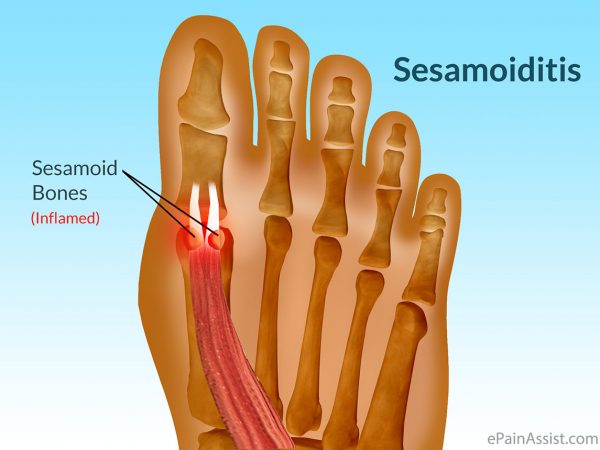Sesamoiditis: Causes, Diagnosis, and Management

What is Sesamoiditis?
Sesamoiditis is a common condition among athletes in which inflammation occurs in the sesamoid bones in the balls of the feet. These bones, whose main function is to assist foot tendons in the movement of the big toe, can be injured either through athletic activity, such as dancing or running, or improper footwear like high heels. It can also occur with people who have begun a new exercise program, since their bodies are adjusting to the new physical regimen. It is more common in younger people than it is in older people.
Causes of Sesamoiditis
- Sudden increase in activity
- Increase in physically strenuous movement without a proper warm up or build up
- Foot structure: those who have smaller, bonier feet or those with a high arch may be more susceptible
Sesamoiditis Symptoms & Diagnosis
Symptoms include pain and inflammation, which can worsen with activities like walking. Pain may also be caused by the inflammation of tendons surrounding the bones. The symptoms begin with slight irritation around the joint shortly after the increase in activity. The discomfort eventually turns to pain with light swelling and possibly redness. Although redness or bruising are rare, this may be a symptom. After each session of exercising, the aggravated joint becomes more irritated and increases into a very intense throbbing.
Sesamoiditis is fairly simple to diagnose since the symptoms have a gradual onset rather than a sudden impact. Diagnosis of sesamoiditis is conducted through bone scans or MRIs.
Treating Sesamoiditis
Treatment for sesamoiditis can vary depending on the severity but is almost always non-invasive and simple. Doctors may recommend a strict rest period where the patient forgoes most physical activity. This will help give the patient time to heal their feet through limited activity.
If you must be active, a recommendation for as modified shoe or insole, along with bandaging and immobilizing the big toe will be made to ensure that pressure is not placed on the joint. For severe cases, it is typically recommended that the joint and the big toe be completely immobilized to allow adequate time to heal. Ice and an over the counter anti-inflammatory may can help with the pain and discomfort while you are at rest.
When you return to your regular exercise activities, it is recommended that you use an insole that will allow even distribution of impact to your entire foot, rather than just the balls of your foot. This will prevent further aggravation of the injury.
It is best to speak with your doctor to determine a treatment option that will help your specific needs. It is important to seek treatment in its early stages because if you ignore the pain, this condition can lead to more serious problems such as severe irritation and bone fractures.
Contact a Podiatrist
Sesamoiditis is an unpleasant foot condition characterized by pain in the balls of the feet. The best way in which one can help manage this condition is by seeing a podiatrist, who may prescribe physical therapy, anti-inflammatory drugs, and rest to help the sesamoid bones to heal. If you think you’re struggling with sesamoiditis, contact Dr. Spencer Hardy of Red Mountain Footcare. Our doctor will treat your condition thoroughly and effectively.
If you have any questions, please feel free to contact us or schedule an appointment at our office located in Mesa, AZ. We offer the newest diagnostic and treatment technologies for all your foot and ankle needs.
Read more about Sesamoiditis
